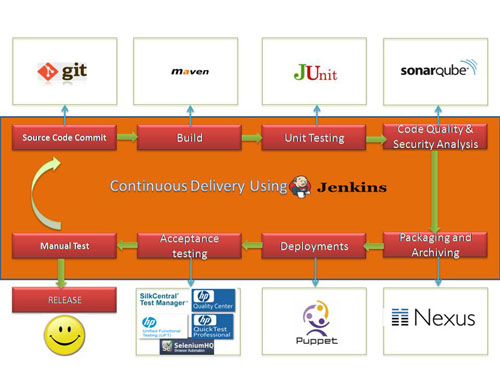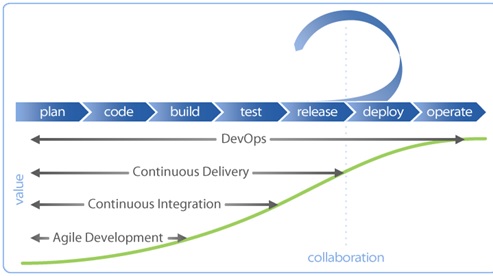Training Flow


DevOps integrates developers and operation teams in order to improve collaboration and productivity by automation infrastructure, automating workflows and continuously application performance. DevOps helps you deliver the best user experience possible and benefits your company by increasing the frequency of deployments of your software and services. DevOps helps to improve performance and quickly release of application. As rapid delivery of software has become a strategic business asset, progressive IT organizations are pursuing a DevOps culture, where development and operations teams, systems, and tools work in lockstep. By aligning goals and sharing tools and strategies, you can improve velocity and code quality, allowing you to innovate faster. In this course, we look at the necessity of Devops and how a DevOps transformation can help focus on value and streamlined delivery of your software. We will also cover concepts like Automation, tools & technology which play huge roles in DevOps success.
| TOOLS COVERED | Ansible, Ansible Tower | |||||
|---|---|---|---|---|---|---|
Duration |
Time |
Location |
Mode |
Fees |
||
6 Days |
10:00 AM to 6:30 PM) |
Bangalore |
Classroom (Public Batch) |
INR 19999/- Per candidate |
||


Video Mode using LMS
Video Mode using LMS
Video Mode using LMS
Agenda: Jira Essential Training (Classroom)
What is Git?
Installing Git
Getting Started
Git Concepts and Architecture
Making Changes to Files
Undoing Changes
Ignoring Files
Navigating the Commit Tree
Branching
Merging Branches
Requirements
Going Further
Crash Demo of Setting up Puppet master
Crash Demo of Setting up Puppet Agent
Crash Demo of setting up environment
Crash Demo of running puppet module using master
Day - 2
Getting started
Tagging
Agent
Integrations
Watchdog
Graphing
Alerting
APM (Tracing)
Log Management
Developer Tools
API
Account Management
Security
What Is Splunk?
Setting up the Splunk environment
Basic Searching Techniques
Enterprise Splunk Architecture
Splunking for DevOps and Security
Application Development in Splunkbase
Splunking on Hadoop with Hunk
Installing and Configuring NewRelic APM Agents for Application
Working with NewRelic Dashboard
Day - 1
Day - 2
To maintain the quality of our live sessions, we allow limited number of participants. Therefore, unfortunately live session demo cannot be possible without enrollment confirmation. But if you want to get familiar with our training methodology and process or trainer's teaching style, you can request a pre recorded Training videos before attending a live class.
Yes, after the training completion, participant will get one real-time scenario based project where they can impletement all their learnings and acquire real-world industry setup, skills, and practical knowledge which will help them to become industry-ready.
All our trainers, instructors and faculty members are highly qualified professionals from the Industry and have at least 10-15 yrs of relevant experience in various domains like IT, Agile, SCM, B&R, DevOps Training, Consulting and mentoring. All of them has gone through our selection process which includes profile screening, technical evaluation, and a training demo before they onboard to led our sessions.
No. But we help you to get prepared for the interviews and resume preparation as well. As there is a big demand for DevOps professionals, we help our participants to get ready for it by working on a real life projects and providing notifications through our "JOB updates" page and "Forum updates" where we update JOB requirements which we receive through emails/calls from different-different companies who are looking to hire trained professionals.
The system requirements include Windows / Mac / Linux PC, Minimum 2GB RAM and 20 GB HDD Storage with Windows/CentOS/Redhat/Ubuntu/Fedora.
All the Demo/Hands-on are to be executed by our trainers on DevOpsSchool's AWS cloud. We will provide you the step-wise guide to set up the LAB which will be used for doing the hands-on exercises, assignments, etc. Participants can practice by setting up the instances in AWS FREE tier account or they can use Virtual Machines (VMs) for practicals.
Please email to contact@DevopsSchool.com
You will never lose any lecture at DevOpsSchool. There are two options available: You can view the class presentation, notes and class recordings that are available for online viewing 24x7 through our Learning management system (LMS). You can attend the missed session, in any other live batch or in the next batch within 3 months. Please note that, access to the learning materials (including class recordings, presentations, notes, step-bystep-guide etc.)will be available to our participants for lifetime.
Yes, Classroom training is available in Bangalore, Hyderabad, Chennai and Delhi location. Apart from these cities classroom session can be possible if the number of participants are 6 plus in that specific city.
Location of the training depends on the cities. You can refer this page for locations:- Contact
We use GoToMeeting platform to conduct our virtual sessions.
DevOpsSchool provides "DevOps Certified Professional (DCP)" certificte accredited by DevOpsCertificaiton.co which is industry recognized and does holds high value. Particiapant will be awarded with the certificate on the basis of projects, assignments and evaluation test which they will get within and after the training duration.
If you do not want to continue attend the session in that case we can not refund your money back. But, if you want to discontinue because of some genuine reason and wants to join back after some time then talk to our representative or drop an email for assistance.
Our fees are very competitive. Having said that if the
participants are in a group then following discounts can be possible based
on the
discussion with representative
Two to Three students – 10% Flat
discount
Four to Six Student – 15% Flat discount
Seven & More – 25% Flat Discount
If you are reaching to us that means you have a genuine need of this training, but if you feel that the training does not fit to your expectation level, You may share your feedback with trainer and try to resolve the concern. We have no refund policy once the training is confirmed.
You can know more about us on Web, Twitter, Facebook and linkedin and take your own decision. Also, you can email us to know more about us. We will call you back and help you more about the trusting DevOpsSchool for your online training.
If the transaction occurs through the website payment gateway, the participant will receive an invoice via email automatically. In rest options, participant can drop an email or contact to our representative for invoice

Abhinav Gupta, Pune
(5.0)The training was very useful and interactive. Rajesh helped develop the confidence of all.

Indrayani, India
(5.0)Rajesh is very good trainer. Rajesh was able to resolve our queries and question effectively. We really liked the hands-on examples covered during this training program.

Ravi Daur , Noida
(5.0)Good training session about basic Devops concepts. Working session were also good, howeverproper query resolution was sometimes missed, maybe due to time constraint.

Sumit Kulkarni, Software Engineer
(5.0)Very well organized training, helped a lot to understand the DevOps concept and detailed related to various tools.Very helpful

Vinayakumar, Project Manager, Bangalore
(5.0)Thanks Rajesh, Training was good, Appreciate the knowledge you poses and displayed in the training.

Abhinav Gupta, Pune
(5.0)The training with DevOpsSchool was a good experience. Rajesh was very helping and clear with concepts. The only suggestion is to improve the course content.